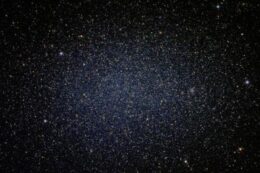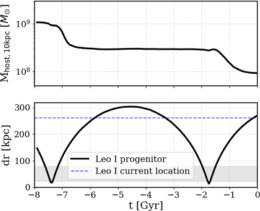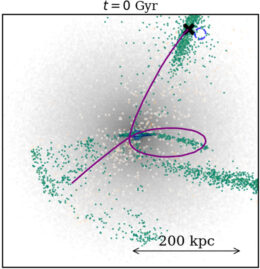Leo I is a distant dwarf galaxy that appears to host a supermassive black hole 100 times more massive than expected for a galaxy of its size. Could tidal stripping explain this galaxy’s black hole–stellar mass mismatch?
An Anomalously Large Black Hole

The dwarf galaxy Leo I. [Sloan Digital Sky Survey; CC BY 4.0]
Leo I is remarkable not just because it’s the Milky Way’s most distant satellite, but also because this 80-million-solar-mass galaxy appears to harbor a 3-million-solar-mass black hole — a black hole nearly as massive as the Milky Way’s central supermassive black hole but in a galaxy more than 10,000 times less massive. To explain this discrepancy, researchers have proposed that Leo I was once a much larger galaxy that has had its stars stolen by passing too close to the Milky Way.
Simulating Stellar Stripping
Fabio Pacucci (Center for Astrophysics | Harvard & Smithsonian; Black Hole Initiative) and collaborators used analytical and dynamical models to explore how Leo I’s past journeys close to the Milky Way might have robbed the smaller galaxy of its stars. Using a simple analytical model, the team estimated that Leo I could have lost 32–57% of its stars after one close passage, though losses up to 78% are possible based on precise observations by the star-mapping Gaia spacecraft.

Stellar mass (top panel) and distance between Leo I and the Milky Way (bottom panel) over time. [Pacucci et al. 2023]
Possible, but Probable?
Pacucci’s team notes that this scenario, though possible, may be unlikely for two reasons. First, it requires Leo I to pass very close to the Milky Way on two occasions, at the limit of what is permitted by Gaia observations. Second, Leo I’s metal content — the abundance of elements heavier than helium — matches what we’d expect for a galaxy of its size; a galaxy that used to be more massive should be more metal rich.

Modeled locations of Leo I’s stars today (green circles) and black hole over the past 8 billion years (purple line). You can see an animation of this figure here. [Adapted from Pacucci et al. 2023]
In-depth statistical modeling delving into the likelihood of this scenario awaits future work, and observations may yet dredge up evidence of Leo I’s stellar streams. If future work supports the team’s hypothesis, another possibility waits in the wings: that Leo I will someday relinquish all of its stars to the Milky Way and become a wandering black hole.
Citation
“Extreme Tidal Stripping May Explain the Overmassive Black Hole in Leo I: A Proof of Concept,” Fabio Pacucci et al 2023 ApJL 956 L37. doi:10.3847/2041-8213/acff5e

